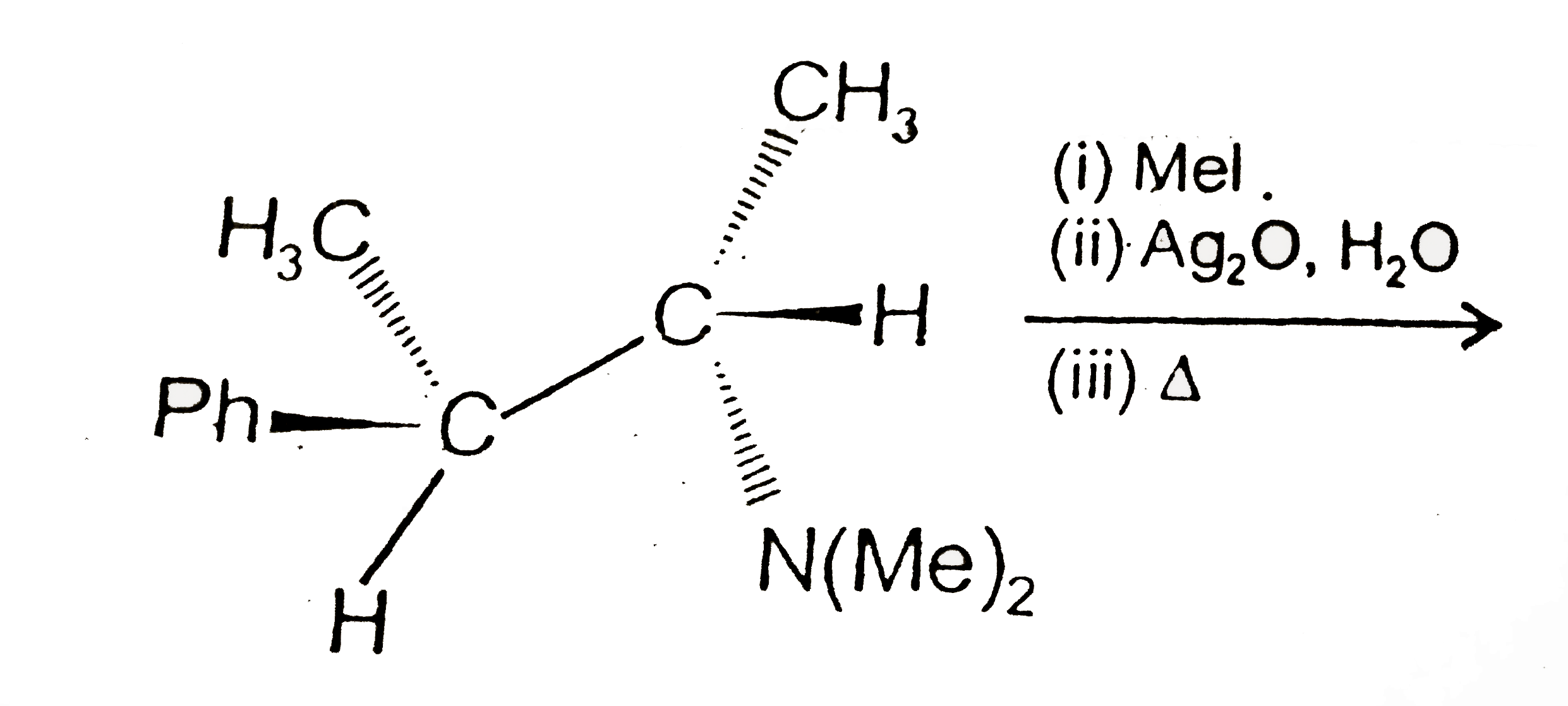The major product obtained from photochemical chlorination of etylbenzene (in excess) is hydrolyzed with aqueous KOH. The final product formed is
PhCH2CHO
PhCOCH3
PhCHO
PhCOOH
The correct Answer is:B
To solve the problem of identifying the final product formed from the photochemical chlorination of ethylbenzene followed by hydrolysis with aqueous KOH, we can follow these steps:
Step 1: Understand the structure of ethylbenzene
Ethylbenzene is an aromatic compound with the formula C6H5C2H5. It consists of a benzene ring attached to an ethyl group.
Hint: Draw the structure of ethylbenzene to visualize the positions of the hydrogen atoms that can be substituted.
Step 2: Photochemical chlorination of ethylbenzene
In the presence of UV light, ethylbenzene undergoes photochemical chlorination. This process involves the formation of free radicals. The chlorine (Cl2) splits into two chlorine radicals (Cl•), which can abstract hydrogen atoms from ethylbenzene.
Hint: Remember that the stability of the free radical formed will influence which hydrogen is replaced by chlorine.
Step 3: Identify the more stable free radical
The ethylbenzene can form free radicals at two positions: the benzylic carbon (the carbon attached to the benzene ring) and the ethyl carbon. The benzylic radical is more stable due to resonance stabilization.
Hint: Consider the stability of radicals when determining which hydrogen will be substituted.
Step 4: Formation of the chlorinated product
The more stable benzylic radical leads to the substitution of a hydrogen atom on the benzylic carbon with a chlorine atom. The major product of the chlorination will be 1-chloroethylbenzene (C6H5C(Cl)H2).
Hint: Write down the structure of the chlorinated product to keep track of the changes.
Step 5: Hydrolysis with aqueous KOH
The next step involves hydrolysis of the chlorinated product with aqueous KOH. This reaction typically proceeds via an SN1 mechanism, where the chlorine atom is replaced by a hydroxyl group (OH).
Hint: Remember that the nucleophile (OH-) will attack the carbocation formed after the departure of the leaving group (Cl).
Step 6: Formation of the alcohol
After the chlorine leaves, a carbocation is formed. The hydroxide ion (OH-) from KOH will then attack this carbocation, resulting in the formation of an alcohol. The product will be phenethyl alcohol (C6H5CH2OH).
Hint: Visualize the transition from the chlorinated compound to the alcohol to ensure you understand the mechanism.
Step 7: Oxidation of the alcohol
The final step involves the oxidation of the formed alcohol. Since phenethyl alcohol is a secondary alcohol, it can be oxidized to a ketone using an oxidizing agent such as PCC (Pyridinium chlorochromate).
Hint: Identify the product of the oxidation reaction, which will be a ketone.
Step 8: Final product
The final product after oxidation will be acetophenone (C6H5COCH3).
Hint: Confirm the structure of the final product to ensure it matches the expected outcome.
Conclusion
The final product formed from the photochemical chlorination of ethylbenzene followed by hydrolysis with aqueous KOH and subsequent oxidation is acetophenone (C6H5COCH3).
---
Ethylbenzene is an aromatic compound with the formula C6H5C2H5. It consists of a benzene ring attached to an ethyl group.
In the presence of UV light, ethylbenzene undergoes photochemical chlorination. This process involves the formation of free radicals. The chlorine (Cl2) splits into two chlorine radicals (Cl•), which can abstract hydrogen atoms from ethylbenzene.
The ethylbenzene can form free radicals at two positions: the benzylic carbon (the carbon attached to the benzene ring) and the ethyl carbon. The benzylic radical is more stable due to resonance stabilization.
The more stable benzylic radical leads to the substitution of a hydrogen atom on the benzylic carbon with a chlorine atom. The major product of the chlorination will be 1-chloroethylbenzene (C6H5C(Cl)H2).
The next step involves hydrolysis of the chlorinated product with aqueous KOH. This reaction typically proceeds via an SN1 mechanism, where the chlorine atom is replaced by a hydroxyl group (OH).
After the chlorine leaves, a carbocation is formed. The hydroxide ion (OH-) from KOH will then attack this carbocation, resulting in the formation of an alcohol. The product will be phenethyl alcohol (C6H5CH2OH).
The final step involves the oxidation of the formed alcohol. Since phenethyl alcohol is a secondary alcohol, it can be oxidized to a ketone using an oxidizing agent such as PCC (Pyridinium chlorochromate).
The final product after oxidation will be acetophenone (C6H5COCH3).
The final product formed from the photochemical chlorination of ethylbenzene followed by hydrolysis with aqueous KOH and subsequent oxidation is acetophenone (C6H5COCH3).
Similar Questions
Knowledge Check

Major product formed is :A B
B C
C D
D
The major product obtained in the reaction
 A
A B
B C
C D
D
The major product obtained in the reaction is

View SolutionThe major product obtained in the following reaction is:

View SolutionThe major product obtained in the following reaction is :

View SolutionThe major product obtained in the following reaction is :

View SolutionThe major product obtained in the following reaction is:

View SolutionThe major product obtained in the following reaction is :

View Solution

 . The major product obtained is
. The major product obtained is 